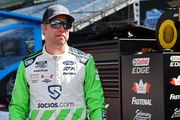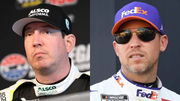
via Imago
TALLADEGA, AL – APRIL 22: Blaine Perkins ( 02 Ollie s Bargain Outlet Our Motorsports Chevrolet) crashes on the back stretch during the running of the NASCAR, Motorsport, USA Xfinity Series Ag-Pro 300 on April 22,2023 at Talladega SuperSpeedway in Talladega, AL. (Photo by Jeff Robinson/Icon Sportswire) AUTO: APR 22 NASCAR Xfinity Series Ag-Pro 300 EDITORIAL USE ONLY Icon2304223002636

via Imago
TALLADEGA, AL – APRIL 22: Blaine Perkins ( 02 Ollie s Bargain Outlet Our Motorsports Chevrolet) crashes on the back stretch during the running of the NASCAR, Motorsport, USA Xfinity Series Ag-Pro 300 on April 22,2023 at Talladega SuperSpeedway in Talladega, AL. (Photo by Jeff Robinson/Icon Sportswire) AUTO: APR 22 NASCAR Xfinity Series Ag-Pro 300 EDITORIAL USE ONLY Icon2304223002636
Daytona has often been the scene of some hair-raising crashes. Living up to the cautionary tales spun by Denny Hamlin and Daniel Suarez, the regular season’s curtain-closer was nothing short of a demolition derby. As the dust began to settle at the tail end of stage 1, a 16-car pile-up unfolded. But the real heart-stopper came when Tony Stewart‘s driver, Ryan Preece‘s car, took a wild ride, somersaulting through the air a staggering over seven times.
Eyes were peeled for news on Preece’s condition, but, against all odds, he emerged from the hospital the next day without significant harm. Still, the incident fanned the flames of debate about racetrack safety. From Denny Hamlin to the NASCAR grapevine, many chimed in on potential safety overhauls and speculated on the root causes of such a jaw-dropping crash.
ADVERTISEMENT
Article continues below this ad
A NASCAR insider throws a curveball at Denny Hamlin’s narrative on account of the crash of Ryan Preece
On his “Actions Detrimental” podcast, Hamlin painted a picture where Ryan Preece’s car, after a nudge from Eric Jones and tangling with Chase Briscoe, was, according to him, already soaring before it even brushed the turf.
However, video footage doing the rounds suggests otherwise. The Door Bumper Clear trio—Brett Griffin, Freddie Kraft, and TJ Majors—cried foul. Griffin didn’t mince words, refuting Hamlin’s account, saying, “I don’t really think that was accurate at all. It started to take off as soon as it hit the grass, when it started with that violent fumble. So, is it all to me? Sliding in there, when it hit the grass, that’s when it rose.”
Freddie Kraft and TJ Majors, donning their thinking caps, proposed a simple remedy to such major deadly accidents: dial down the speed. Majors, drawing a parallel with the Atlanta race, opined, “We need to go slower, in my opinion, because we’ll race better. You look at Atlanta—look at how many times we passed Atlanta vs. how many times we passed Daytona. We need to race slower, I would say, just so the racing is better.”
Kraft echoed the sentiment, suggesting a deceleration of 20–30 miles per hour could be the way to go. However, Griffin had another card up his sleeve, proposing a different antidote for cars taking unwanted leaps on the grass.
Watch This Story: Tony Stewart’s Team Under Scrutiny After Disappointing Regular Season With Ford
ADVERTISEMENT
Article continues below this ad
Trending
What is another suggestion to dodge such harrowing crashes?
While the DBC duo, TJ Majors and Freddie Kraft, felt such airborne antics were par for the course given the blistering speeds, Brett Griffin pitched an idea: if the green’s the culprit, why not pull it up by the roots when necessary?
In Griffin’s words, “It’s been a long time since I have seen a cup car flip and look like it was a sprint car flipping. Because of the revolutions per second in the flip, I will say this about the grass, though: I am all for it if you are making a mistake having a penalty, right? But at a superspeedway, if grass is a problem too, it’s not that hard to do away with it.”
ADVERTISEMENT
Article continues below this ad
Well, it goes without saying that the car crash involving Ryan Preece was a spine-chilling spectacle. Any remedy to steer clear of such catastrophes should undoubtedly be on NASCAR’s radar.
Read More: NASCAR World Congratulates “Superman” Ryan Preece as Wife Delivers Wholesome Update
ADVERTISEMENT
ADVERTISEMENT
ADVERTISEMENT
ADVERTISEMENT






